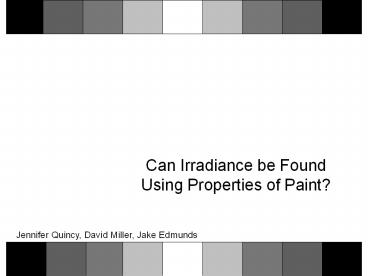Can Irradiance be Found Using Properties of Paint? - PowerPoint PPT Presentation
Title:
Can Irradiance be Found Using Properties of Paint?
Description:
Can Irradiance be Found Using Properties of Paint? Jennifer Quincy, David Miller, Jake Edmunds ... Step 1- Paint hollow steel cubes black and white. ... – PowerPoint PPT presentation
Number of Views:98
Avg rating:3.0/5.0
Title: Can Irradiance be Found Using Properties of Paint?
1
- Can Irradiance be Found Using Properties of Paint?
Jennifer Quincy, David Miller, Jake Edmunds
2
Objective
- Verify solar irradiance at BYU experimentally.
SWKT
CLYDE
WILK
3
The Experiment
Step 1- Paint hollow steel cubes black and
white. Step 2- Place cubes in foam insulation
with one face exposed to sun. Step 3- Allow cubes
to reach steady state temperature. Step 4-
Measure temperature inside of cubes. Step
5-Determine the irradiance G from Energy Balance.
4
Predictions for April 2007
- Average monthly maximum irradiance in April at
BYU is 1100 W/m2 - Mean monthly irradiance in April at BYU is 265
W/m2 - We will measure at noon so the irradiance should
be around 1000 W/m2
5
Theoretical Analysis
- Energy Balance
- qrad,abs qrad,emit qconv 0
- aG esTs4 hconv(Ts - T8) 0
6
About Spray Paint
- Flat White and Flat Black differ slightly
- Flat White 6 Talc, 4 Titanium Dioxide
- Flat Black 4 Talc, .4 Carbon Black
- Everything else in spray paint is VOCs and
solvents that evaporate - Absorptivity will be different, but emissivity
will be virtually the same (mostly IR)
7
Assumptions
- Identical and simultaneous setup allows
comparison of the results from the two colors. - Foam insulation negligibly participates in heat
transfer. - Assumed material constants are accurate.
- At steady state, internal air temp of the cubes
is the same as the surface temp.
8
Material Properties
- aw .5
- ew .98
- ab .9
- eb .98
- These properties are very general they can vary
widely even within the same brand of paint. - Only paint intended for aerospace applications
has constant and well-researched properties.
9
Unknown Values
- Irradiance G
- Steady State Temperatures Tw and Tb
- Ambient Air Temperature T8
- Free convection coefficient hconv
10
Actual Setup
- JFSB, 3rd floor balcony, 12 am, 12 April 2007
- Thermocouples
- in cubes to
- measure temp
11
Observations
- Steady state was reached in 30 minutes
- Light breeze present
- Lightly overcast
- Cool ambient air
12
Measured Temperature
- Steady State Temp
- Tw 21.6C
- Tb 35.1C
- Ambient Temp
- T8 19.8C
13
Convection
- For convection (vlt20 m/s) we used
- h 10.45 - v 10vv
- The light breeze was 1 m/s
- h 20 W/m2K
14
Solution
- G essTs4 hconv(Ts - T8)/as
- White
- G (.985.67e-8(27321.6)420(21.6-19.8))/.5
- G 910 W/m2
- Black
- G (.985.67e-8(27335.1)420(35.1-19.8))/.9
- G 900 W/m2
15
Conclusion
- At 1230 pm, the irradiance at BYU is 900 W/m2.
- We confirmed this with the BYU ESC Weather
Station data. - We verified that the irradiance can be accurately
be found using known properties of paint.
16
(No Transcript)
17
Recommendations
- With a known irradiance, absorptivity of a
different color paint could be found. - Accurately calibrated thermocouples would yield
much greater reliability. - A transparent box could be used to reduce
convection to negligible levels. - Find more accurate values for e and a.
18
References
- Absorptivity and Emissivity www.solarmirror.com/fo
m/fom-serve/cache/43.html - BYU ESC Weather Station marvin.byu.edu/Weather
- Krylon Spray Paint MSDS
- www.kpg-industrial.com/krylon































